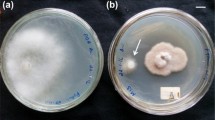Abstract
In recent years, more and more researches focus on endophytic fungi derived from important medicinal plants, which can produce the same bioactive metabolites as their host plants. Salvia miltiorrhiza Bunge is a traditional medicinal plant with versatile pharmacological effects. But the wild plant resource has been in short supply due to the overcollection for bioactive metabolites. Our study was therefore conducted to isolate endophytic fungi from S. miltiorrhiza and get candidate strains that produce the same bioactive compounds as the plant. As a result, an endophyte that produces salvianolic acid C was obtained and identified as Phoma glomerata D14 based on its morphology and internal transcribed spacer analysis. Salvianolic acid C was found present in both the mycelia and fermentation broth. Our study indicates that the endophytic fungus has significant industrial potential to meet the pharmaceutical demands for salvianolic acid C in a cost-effective, easily accessible, and reproducible way.




Similar content being viewed by others
References
Arnold A, Maynard Z, Gilbert G, Coley P, Kursar T (2000) Are tropical fungal endophytes hyperdiverse? Ecol Lett 3:267–274
Chen Y, Zhang N, Ma J, Zhu Y, Wang M, Wang X, Zhang P (2015) A platelet/CMC coupled with offline UPLC-QTOF-MS/MS for screening antiplatelet activity components from aqueous extract of Danshen. J Pharm Biomed Anal 117:178–183
Chun-Yan SU, Ming QL, Rahman K, Han T, Qin LP (2015) Salvia miltiorrhiza: traditional medicinal uses, chemistry, and pharmacology. Chin J Nat Med 13:163–182
Gunatilaka AL (2006) Natural products from plant-associated microorganisms: distribution, structural diversity, bioactivity, and implications of their occurrence. J Nat Prod 69:509–526
Guo LD, Huang GR, Wang Y, He WH, Zheng WH, Hyde KD (2003) Molecular identification of white morphotype strains of endophytic fungi from Pinus tabulaeformis. Mycol Res 107:680–688
Higgins KL, Arnold AE, Miadlikowska J, Sarvate SD, Lutzoni F (2007) Phylogenetic relationships, host affinity, and geographic structure of boreal and arctic endophytes from three major plant lineages. Mol Phylogenet Evol 42:543–555
Lin SH, Huang KJ, Weng CF, Shiuan D (2015) Exploration of natural product ingredients as inhibitors of human HMG-CoA reductase through structure-based virtual screening. Drug Des Dev Therapy 9:3313
Ming QL, Han T, Li WC, Zhang QY, Zhang H, Zheng CJ, Huang F, Rahman K, Qin LP (2012) Tanshinone IIA and tanshinone I production by Trichoderma atroviride D16, an endophytic fungus in Salvia miltiorrhiza. Phytomedicine 19:330–333
Ming QL, Su CY, Zheng CJ, Jia M, Zhang QY, Zhang H, Rahman K, Han T, Qin LP (2013) Elicitors from the endophytic fungus Trichoderma atroviride promote Salvia miltiorrhiza hairy root growth and tanshinone biosynthesis. J Exp Bot 64:5687–5694
Petrini O, Fisher P (1990) Occurrence of fungal endophytes in twigs of Salix fragilis and Quercus robur. Mycol Res 94:1077–1080
Puri SC, Verma V, Amna T, Qazi GN, Spiteller M (2005) An endophytic fungus from Nothapodytes foetida that produces camptothecin. J Nat Prod 68:1717–1719
Saitou N, Nei M (1987) The neighbor-joining method: a new method for reconstructing phylogenetic trees. Mol Biol Evol 4:406–425
Schulz B, Boyle C, Draeger S, Römmert AK, Krohn K (2002) Endophytic fungi: a source of novel biologically active secondary metabolites. Mycol Res 106:996–1004
Stierle A, Strobel G, Stierle D (1993) Taxol and taxane production by Taxomyces andreanae, an endophytic fungus of Pacific yew. Science 260:214–216
Tang W, Eisenbrand G (1992) Chinese drugs of plant origin: chemistry, pharmacology, and use in traditional and modern medicine. Springer-Verlag, Berlin
Thompson JD, Gibson TJ, Plewniak F, Jeanmougin F, Higgins DG (1997) The CLUSTAL_X windows interface: flexible strategies for multiple sequence alignment aided by quality analysis tools. Nucleic Acids Res 25:4876–4882
Yang H, Cheng JJ, Liang G (2010) Induction of mitotic arrest and apoptosis by salvianolic acid C in human hepatoma HepG2 cells. Chin Pharmacol Bull 26:1208–1212
Acknowledgments
This work was supported by the Young Scientist Special Project of the National High Technology Research and Development Program of China (No. 2014AA020508) and the “Chen Guang’’ project supported by Shanghai Municipal Education Commission and Shanghai Education Development Foundation (13CG40).
Author information
Authors and Affiliations
Corresponding authors
Ethics declarations
Conflict of interest
The authors declare no conflicts of interest relating to this paper.
Additional information
Xiuqing Li and Xin Zhai have contributed equally to this manuscript.
Rights and permissions
About this article
Cite this article
Li, X., Zhai, X., Shu, Z. et al. Phoma glomerata D14: An Endophytic Fungus from Salvia miltiorrhiza That Produces Salvianolic Acid C. Curr Microbiol 73, 31–37 (2016). https://doi.org/10.1007/s00284-016-1023-y
Received:
Accepted:
Published:
Issue Date:
DOI: https://doi.org/10.1007/s00284-016-1023-y




